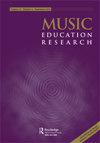Cognitive processing of rhythm in primary education: encounters between teaching practice and scientific evidence
IF 1.8
3区 教育学
Q2 EDUCATION & EDUCATIONAL RESEARCH
引用次数: 0
Abstract
ABSTRACT
This paper explores how Chilean teachers approach fundamental aspects of rhythm, verifying their consistency with cognitive processing theory and findings. 203 music teachers completed a validated questionnaire with closed and open items regarding how they approach pulse, tempo, meter and rhythmic patterns during rhythm production and perception activities. The results show that, in general, teaching practices are congruent with the scientific evidence related to the processing of these musical aspects. Finally, the use of elements that facilitate synchronization or constant pulse is suggested: optimal tempi ranges for adults, use of binary meters, and the use of rhythmic patterns that prioritise the double-half relationship.
小学教育中节奏的认知加工:教学实践与科学证据的碰撞
摘要本文探讨了智利教师如何处理节奏的基本方面,并验证了他们与认知加工理论和研究结果的一致性。203名音乐教师完成了一份经过验证的问卷,问卷包含了关于他们在节奏产生和感知活动中如何处理脉搏、速度、节拍和节奏模式的封闭式和开放式项目。结果表明,总体而言,教学实践与这些音乐方面的加工相关的科学证据是一致的。最后,建议使用促进同步或恒定脉冲的元素:成人的最佳节奏范围,使用二进制拍子,以及使用优先考虑双半关系的节奏模式。
本文章由计算机程序翻译,如有差异,请以英文原文为准。
求助全文
约1分钟内获得全文
求助全文

 求助内容:
求助内容: 应助结果提醒方式:
应助结果提醒方式:


